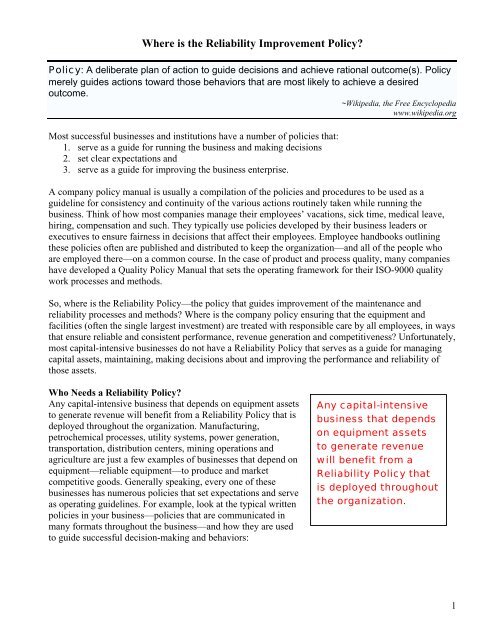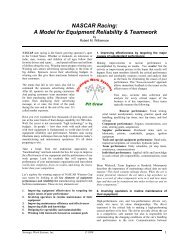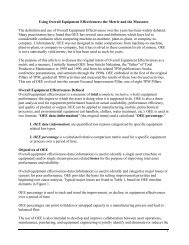Where is the Reliability Improvement Policy? - Strategic Work Systems
Where is the Reliability Improvement Policy? - Strategic Work Systems
Where is the Reliability Improvement Policy? - Strategic Work Systems
You also want an ePaper? Increase the reach of your titles
YUMPU automatically turns print PDFs into web optimized ePapers that Google loves.
<strong>Where</strong> <strong>is</strong> <strong>the</strong> <strong>Reliability</strong> <strong>Improvement</strong> <strong>Policy</strong>?<strong>Policy</strong>: A deliberate plan of action to guide dec<strong>is</strong>ions and achieve rational outcome(s). <strong>Policy</strong>merely guides actions toward those behaviors that are most likely to achieve a desiredoutcome.~Wikipedia, <strong>the</strong> Free Encyclopediawww.wikipedia.orgMost successful businesses and institutions have a number of policies that:1. serve as a guide for running <strong>the</strong> business and making dec<strong>is</strong>ions2. set clear expectations and3. serve as a guide for improving <strong>the</strong> business enterpr<strong>is</strong>e.A company policy manual <strong>is</strong> usually a compilation of <strong>the</strong> policies and procedures to be used as aguideline for cons<strong>is</strong>tency and continuity of <strong>the</strong> various actions routinely taken while running <strong>the</strong>business. Think of how most companies manage <strong>the</strong>ir employees’ vacations, sick time, medical leave,hiring, compensation and such. They typically use policies developed by <strong>the</strong>ir business leaders orexecutives to ensure fairness in dec<strong>is</strong>ions that affect <strong>the</strong>ir employees. Employee handbooks outlining<strong>the</strong>se policies often are publ<strong>is</strong>hed and d<strong>is</strong>tributed to keep <strong>the</strong> organization—and all of <strong>the</strong> people whoare employed <strong>the</strong>re—on a common course. In <strong>the</strong> case of product and process quality, many companieshave developed a Quality <strong>Policy</strong> Manual that sets <strong>the</strong> operating framework for <strong>the</strong>ir ISO-9000 qualitywork processes and methods.So, where <strong>is</strong> <strong>the</strong> <strong>Reliability</strong> <strong>Policy</strong>—<strong>the</strong> policy that guides improvement of <strong>the</strong> maintenance andreliability processes and methods? <strong>Where</strong> <strong>is</strong> <strong>the</strong> company policy ensuring that <strong>the</strong> equipment andfacilities (often <strong>the</strong> single largest investment) are treated with responsible care by all employees, in waysthat ensure reliable and cons<strong>is</strong>tent performance, revenue generation and competitiveness? Unfortunately,most capital-intensive businesses do not have a <strong>Reliability</strong> <strong>Policy</strong> that serves as a guide for managingcapital assets, maintaining, making dec<strong>is</strong>ions about and improving <strong>the</strong> performance and reliability ofthose assets.Who Needs a <strong>Reliability</strong> <strong>Policy</strong>?Any capital-intensive business that depends on equipment assetsto generate revenue will benefit from a <strong>Reliability</strong> <strong>Policy</strong> that <strong>is</strong>deployed throughout <strong>the</strong> organization. Manufacturing,petrochemical processes, utility systems, power generation,transportation, d<strong>is</strong>tribution centers, mining operations andagriculture are just a few examples of businesses that depend onequipment—reliable equipment—to produce and marketcompetitive goods. Generally speaking, every one of <strong>the</strong>sebusinesses has numerous policies that set expectations and serveas operating guidelines. For example, look at <strong>the</strong> typical writtenpolicies in your business—policies that are communicated inmany formats throughout <strong>the</strong> business—and how <strong>the</strong>y are usedto guide successful dec<strong>is</strong>ion-making and behaviors:Any capital-intensivebusiness that dependson equipment assetsto generate revenuewill benefit from a<strong>Reliability</strong> <strong>Policy</strong> that<strong>is</strong> deployed throughout<strong>the</strong> organization.1
• Safety and accident prevention policies• Quality and defect prevention policies• Environmental and pollution prevention policies• Human resources policies• Finance and accounting policies• Privacy and personal information policies• Corporate social responsibility policy• Information systems and data management policies• Business ethics policies• Shareholder and dividend policies• Proprietary and business information policies• Purchasing and procurement policiesWhen <strong>the</strong>re <strong>is</strong> nopolicy, how does acompany expect itsemployees to respondto equipmentmaintenance andreliability questions,problems,opportunities andimprovements?When <strong>the</strong>re <strong>is</strong> no policy, how does a company expect its employees to respond to equipmentmaintenance and reliability questions, problems, opportunities and improvements? If you want toimprove <strong>the</strong> way your equipment and facilities are operated and maintained, how <strong>the</strong>y are cared for andhow <strong>the</strong>ir performance <strong>is</strong> improved, you need a <strong>Reliability</strong> <strong>Policy</strong>—or better yet, a <strong>Reliability</strong><strong>Improvement</strong> <strong>Policy</strong>. Such a policy should originate at <strong>the</strong> top levels of <strong>the</strong> company and may be fairlygeneral in regard to plans, schedules and tactics. A guiding coalition of formal and informal leadersshould structure <strong>the</strong> policy statement.What Should a <strong>Policy</strong> Statement Contain?The <strong>Reliability</strong> <strong>Improvement</strong> <strong>Policy</strong> statement should become more and more explicit as it <strong>is</strong> interpretedfrom <strong>the</strong> top down through <strong>the</strong> organization. At <strong>the</strong> lowest leadership level (plant, area, department), itshould be a specific plan or a strategy for taking action that <strong>is</strong> cons<strong>is</strong>tent with <strong>the</strong> <strong>Reliability</strong><strong>Improvement</strong> <strong>Policy</strong> statement.A <strong>Reliability</strong> <strong>Improvement</strong> <strong>Policy</strong> statement should be explicit regarding:• The compelling business reason for improving equipment and/or process reliability;• The acceptable maintenance and reliability work processes and standards;• What <strong>is</strong> to be improved;• How reliability improvement will be measured;• The timeframes in which reliability improvement should be made.How Do You Deploy th<strong>is</strong> Type of <strong>Policy</strong>?A time-proven method for developing and establ<strong>is</strong>hing company improvement policies <strong>is</strong> called policydeployment. The purpose of policy deployment <strong>is</strong> to enable <strong>the</strong> shift from <strong>the</strong> status quo to make majorperformance improvements by analyzing and addressing current business competition opportunities andoperational problems.<strong>Policy</strong> deployment methods called “Hoshin Planning” (Hoshin Kanri), a system of strategic andoperational planning, were developed and refined by numerous companies such as Toyota, NipponDenso, Komatsu and o<strong>the</strong>rs in Japan during <strong>the</strong> 1960s. These companies blended proven ideas from Dr.Edward Deming (PDCA cycle), Dr. Joseph Juran (quality policy) and Dr. Peter Drucker (MBO) intostrategic planning to create <strong>the</strong> Hoshin Planning methodology—and since <strong>the</strong> 1980s, many well-knownbusinesses in <strong>the</strong> United States have made significant and sustainable improvements using it. Th<strong>is</strong>policy deployment process continues to thrive in many successful Lean Enterpr<strong>is</strong>e businesses.2
<strong>Policy</strong> Deployment cascades, or deploys, top management policiesand targets down <strong>the</strong> management hierarchy. At each level, <strong>the</strong>policy <strong>is</strong> translated into policies, targets and actions for <strong>the</strong> nextlevel down. Using a “<strong>Policy</strong> Deployment” strategy for establ<strong>is</strong>hingand infusing a “<strong>Reliability</strong> <strong>Improvement</strong> <strong>Policy</strong>” makes sense: Itwill connect <strong>the</strong> important factors of business success from <strong>the</strong>highest levels of <strong>the</strong> company to <strong>the</strong> plant-floor workgroups and<strong>the</strong>n back to <strong>the</strong> top levels.Without a commondirection, focusedleadership andengaged workgroupsat all levels, almostany improvementprocess <strong>is</strong> doomed tofailure or, at best,stagnation.Th<strong>is</strong> <strong>Policy</strong> Deployment “line of sight” acts as a compass, pointingnorth, keeping <strong>the</strong> entire organization heading in <strong>the</strong> right direction.Without a common direction, focused leadership and engagedworkgroups at all levels, almost any improvement process <strong>is</strong> doomed to failure or, at best, stagnation.So, <strong>Where</strong> Are We Going?The Cheshire Cat in Lew<strong>is</strong> Carroll’s Alice in Wonderland has been paraphrased time and again by thoseof us considering <strong>the</strong> direction of continuous improvement in our industrial operations: “If you don’tknow where you’re going, any road will get you <strong>the</strong>re.”Accordingly, if we don’t have a <strong>Reliability</strong> <strong>Improvement</strong> <strong>Policy</strong>, how can we possibly hope to achievecons<strong>is</strong>tent and sustainable maintenance and reliability improvement success? The answer to that maybest be summed up in <strong>the</strong> words of ano<strong>the</strong>r particularly insightful “cat”: “Coming toge<strong>the</strong>r <strong>is</strong> abeginning. Keeping toge<strong>the</strong>r <strong>is</strong> progress. <strong>Work</strong>ing toge<strong>the</strong>r <strong>is</strong> success.” Thank you, Henry Ford.© 2007Robert M. Williamson<strong>Strategic</strong> <strong>Work</strong> <strong>Systems</strong>, Inc.PO Box 70Columbus, NC 28722RobertMW2@cs.com3




